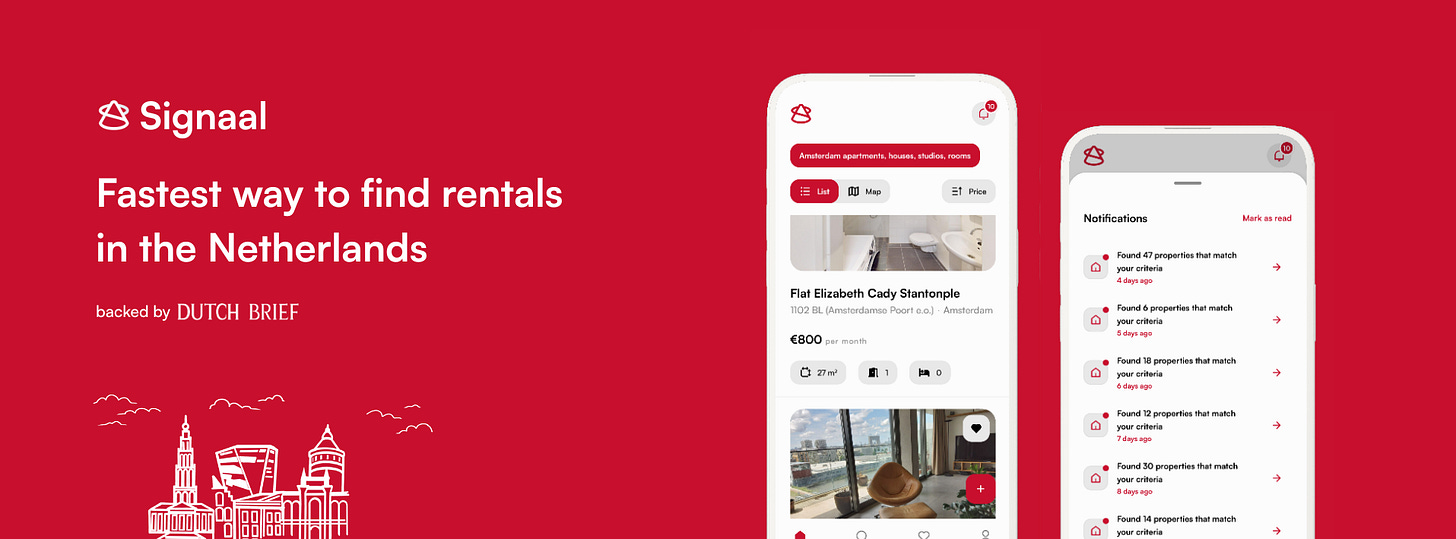Dutch Cycling Rules - Priority, Signs & Fines in 2025
Here's everything you need to know about the cycling culture to ride like a local, with signs, fines and good-to-know tips.
Before we begin, a quick shoutout to our sponsor, Signaal:
Looking for housing in the Netherlands?
Signaal helps you skip the endless scrolling by tracking new listings from trusted platforms and alerting you when something matches your needs, all in one easy-to-use app.
New here and grabbing a bike? Great choice. This guide gets you riding like a local fast: what lane to use, how priority works, what those blue signs mean, and what fines look like in 2025.
1) Pick the right place on the road
Cycle paths first. If you see a round blue sign with a white bicycle (G11), that’s a mandatory cycle path; use it. If you see the rectangular blue “fietspad” (G13), it’s an optional cycle path (you may ride there, walking is allowed too).
Keep right; pass on the left. Ring your bell before overtaking (a bell is required).
2) Hand signals & predictability
Signal clearly with a straight arm before turning left or right; glance over your shoulder first.
At traffic lights, you stop on red; yellow means stop if you can do so safely. An exception exists when you see the blue plate “Rechtsaf voor (brom)fietsers vrij”-cyclists may turn right on red at that location. Always yield to crossing pedestrians.
3) Priority basics you’ll actually use
Default rule: if an intersection has no lights/signs/markings, traffic from the right has priority.
Watch for “shark teeth” (haaientanden) triangles pointing toward you: they mean yield to cross traffic.
Roundabouts vary by signage; a safe rule of thumb is to yield when entering, then follow posted signs and markings for who has priority on the circle.
4) Lights & reflectors (what’s compulsory)
From dusk, in darkness, or poor visibility, you must use:
Front light: white or yellow (steady, not flashing).
Rear light: red (steady).
And your bike must have a red rear reflector (not triangular), yellow reflectors on both pedals, and white or yellow reflectors on tyres/rims. Spoke reflectors (long strips on a spoke) are not allowed—use reflective tyres/rim strips instead.
5) E-bikes vs. speed-pedelecs
Regular e-bikes (up to 25 km/h pedal-assist) follow normal bike rules. Speed pedelecs (up to 45 km/h) are legally treated as mopeds: moped plate, moped licence, helmet, and different speed/road rules (e.g., 45 km/h on carriageways; 40/30 km/h on combined paths outside/inside built-up areas).
Fines cheat-sheet (2025)
Below are typical administrative fines for cyclists in 2025 (amounts exclude/including admin fee can vary slightly by source; think of these as ballpark figures):
Phone in hand while cycling: €170. Hands-free or in a holder is fine; stop using your phone.
No (working) lights in the dark: €75.
Failing to signal a turn: €45.
Overtaking on the right/other incorrect overtakes: €120.
Riding through a red light: €120.
Not using a mandatory cycle path (where required): €75.
On a motorway/expressway: €200 (don’t!).
Cycling under the influence: €200.
Tip: police often do autumn spot-checks for lights. Carry a spare clip-on set in your bag.
Groningen-specific notes you’ll be glad you knew
Bike parking rules: City-wide, don’t block crossings, bus stops, or guidance strips; don’t lock to trees or street furniture. At the station area, the maximum parking time is often 12 days (28 days elsewhere in the city). Overstays and “random parking” in the centre risk removal to the bike depot (AFAC).
“All-green” bike signals: Groningen uses junctions where all cyclists get green at once. There are no special right-of-way rules during this phase—use eye contact and common sense. If the lights are off, normal give-way markings (e.g., shark teeth) apply.
Fietsstraat (cycle street) – “Auto te gast”: very common here. The sign emphasises bikes first and a 30 km/h context for cars, but note the board itself has limited legal status; actual rules come from speed limits/markings and general traffic law. Be predictable, ride central when appropriate, and let cars pass only when it’s safe.
Quick checklist before you roll
Bell works? Brakes good? Tyres pumped?
Lights fitted (or carry clip-ons) and legal reflectors present.
Know your route’s signs: G11 mandatory path, G13 optional path, “Rechtsaf voor (brom)fietsers vrij” for right-on-red, shark teeth = yield. You can study all the signs here.
In Groningen centre: park in racks/garages; avoid removal.
Master these few rules and you’ll ride confidently and avoid costly mistakes. When in doubt, slow down, signal clearly, and follow the markings.





